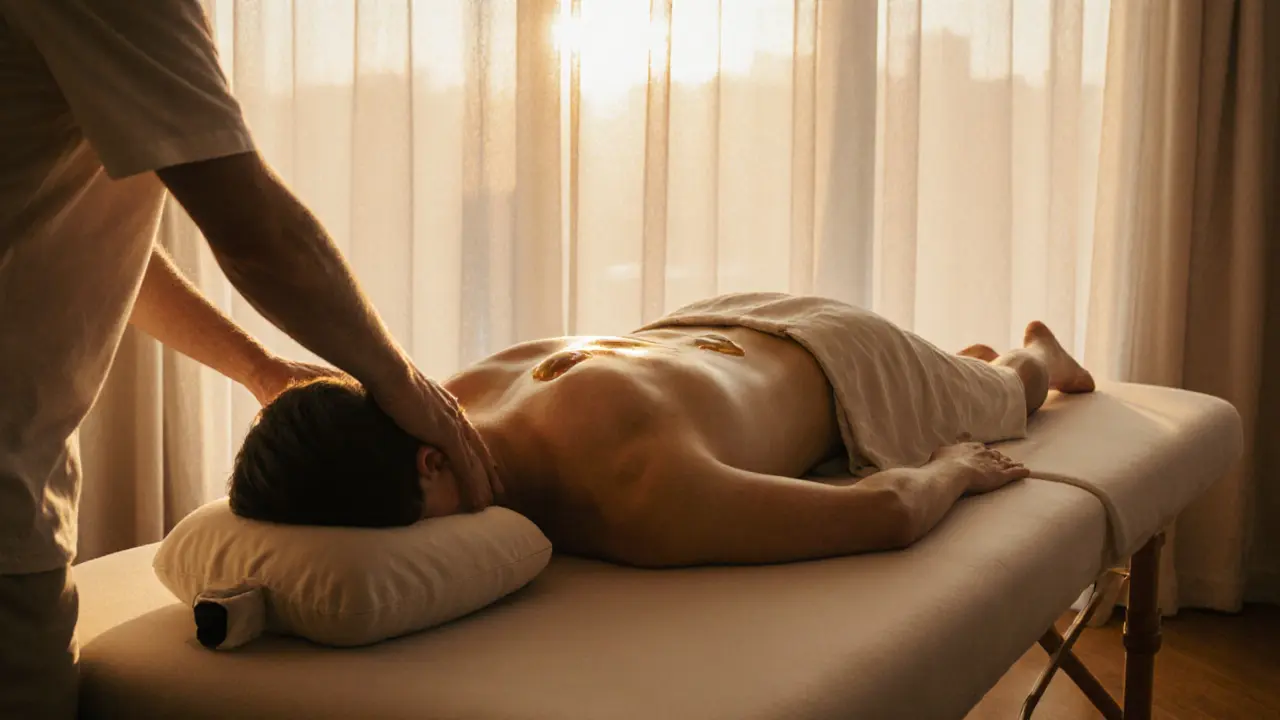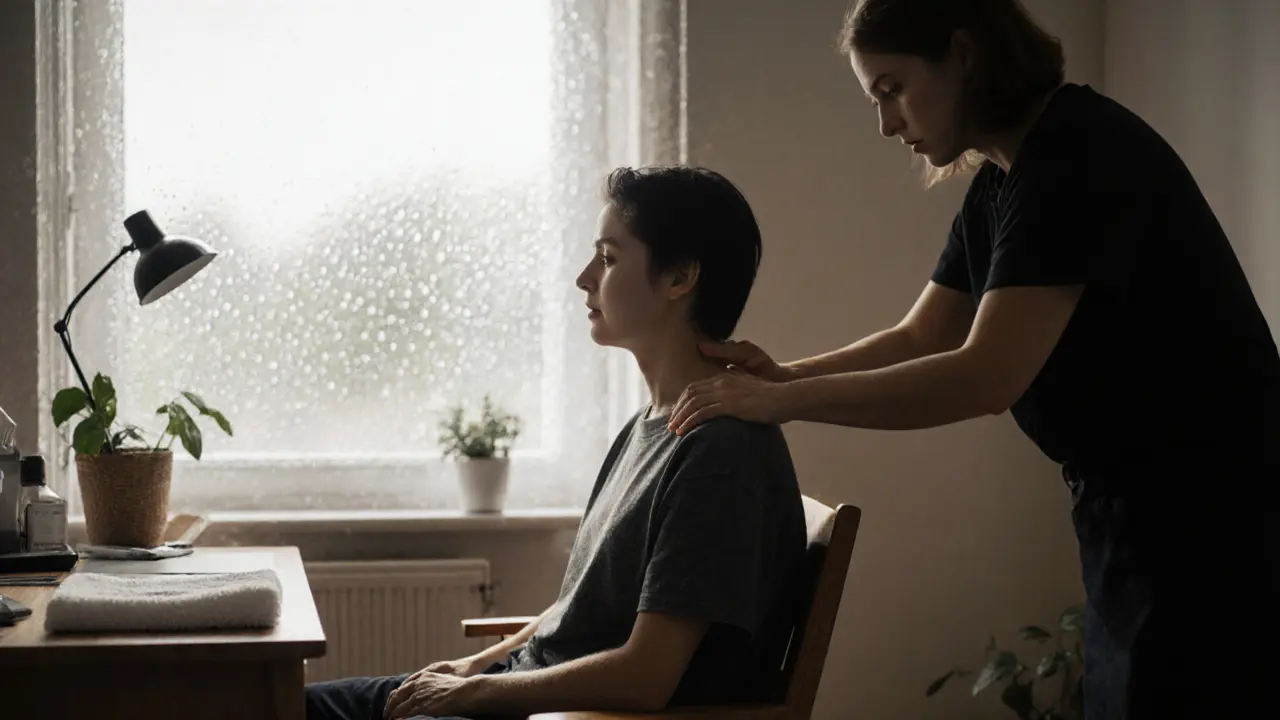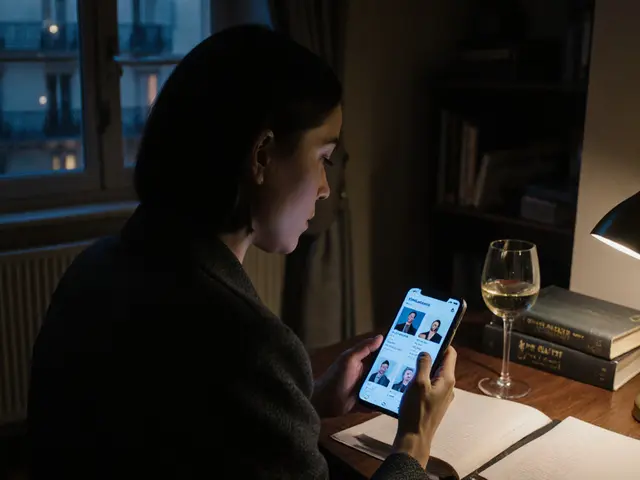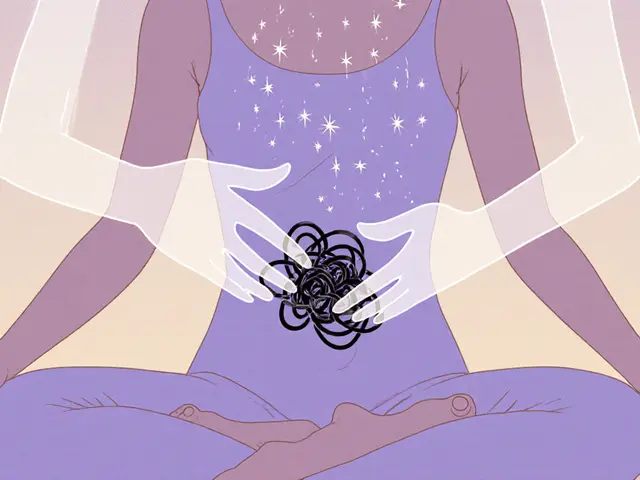Relaxing Massage: The Best Positions for Deep Relaxation

Feeling tense after a long day? You don’t need a spa day or a pricey appointment to find real relaxation. Sometimes, all it takes is the right position-where your body can truly let go. The best relaxing massages aren’t about deep pressure or intense kneading. They’re about stillness, rhythm, and letting gravity do the work. Whether you’re giving a massage or receiving one, the position you choose makes all the difference.
Why Position Matters More Than You Think
Most people think massage is about hand movements. But the truth? The position sets the stage. If your neck is twisted, your shoulders are hunched, or your legs are dangling, your body stays guarded. No amount of oil or thumb pressure will fix that. Relaxation starts when your body feels safe-and that happens when it’s properly supported.
Think of it like lying in a hammock. You don’t have to do anything. You just sink. That’s the goal. The right position lets your muscles unclench without you even trying. Studies show that when the body is aligned and supported, parasympathetic nervous system activity increases. That’s the fancy way of saying your body switches from ‘fight or flight’ to ‘rest and digest’ mode.
Best Position: Lying Face Down (Prone)
This is the classic. And for good reason. Lying face down lets your back, shoulders, and glutes relax completely. But it’s not just about lying flat. You need support under your forehead and hips.
- Place a soft pillow or padded headrest under your forehead so your neck stays neutral-no twisting.
- Put a small bolster or rolled towel under your ankles to take pressure off your lower back.
- If your hips feel tight, slide a pillow under your pelvis. This opens up your lower spine and stops your lower back from arching unnaturally.
This position works best for long, slow strokes-effleurage, where the hands glide like waves over the skin. It’s perfect for releasing tension in the trapezius muscles, which carry most of our daily stress. People who sit at desks all day often feel immediate relief here.
Best Position: Lying on Your Side (Lateral Recumbent)
Not everyone can lie face down. Maybe you’re pregnant, have breathing issues, or just find it uncomfortable. The side-lying position is just as effective-and often more accessible.
- Use a firm pillow between your knees to keep your hips aligned. This prevents your top leg from pulling your spine out of line.
- Rest your bottom arm under your head or let it hang loosely by your side. If it hangs, drape a towel over your arm to keep it warm.
- Support your top shoulder with a pillow so it doesn’t roll forward. This keeps your neck relaxed.
This position is ideal for working on the outer hips, IT band, and side of the torso. It’s also great for people with lower back pain because it reduces spinal compression. Many therapists use this for older clients or those recovering from injury. The key? Slow, rhythmic movements. Don’t rush. Let each stroke last as long as a slow exhale.

Best Position: Sitting Upright in a Chair
You don’t need a massage table. Sometimes, the best relaxing massage happens right at your desk. Sitting upright-correctly-is surprisingly effective.
- Choose a chair with a straight back. No recliners. You want your spine vertical.
- Feet flat on the floor, knees at 90 degrees.
- Let your arms rest loosely on your lap or the armrests.
This is the go-to for neck and shoulder relief. Start at the base of the skull and use your thumbs to make small circles along the top of the trapezius. Move slowly down to the shoulders. Use light pressure-this isn’t about breaking knots. It’s about signaling safety to your nervous system.
People who work in offices report feeling calmer within minutes. The trick? Breathe deeply while they’re being massaged. One study from the University of Miami found that seated neck and shoulder massage for just 10 minutes reduced cortisol levels by 31% in stressed adults.
Best Position: Lying on Your Back (Supine)
This is the most vulnerable position-and that’s why it’s so powerful. When you lie on your back with full support, your body has no choice but to surrender.
- Place a pillow under your knees to take pressure off your lower back.
- Use a small rolled towel under your neck to support the natural curve.
- Let your arms rest by your sides, palms up. This opens the chest and signals relaxation to your brain.
This position is perfect for full-body strokes. Long, sweeping movements from your feet to your head create a wave of calm. It’s especially good for people who carry tension in their chest or jaw. Many find their breathing slows down naturally here. That’s the sign it’s working.
For extra calm, dim the lights and play soft, ambient sound-rain, ocean waves, or white noise. The combination of physical support and sensory calm triggers a deeper state than either alone.
What to Avoid in Any Position
Even the best position won’t help if you do these things:
- Don’t press too hard. Relaxing massage isn’t deep tissue. Too much pressure keeps the body braced.
- Avoid sudden movements. Slow, predictable motion tells your brain it’s safe.
- Don’t skip warmth. Cold hands or a chilly room keep muscles tight. Warm the oil in your hands first.
- Don’t rush. A 15-minute massage done slowly is better than a 45-minute one done like a race.
Also, avoid talking too much. Silence is part of the therapy. Let the touch speak.

How Long Should a Relaxing Massage Last?
Thirty minutes is the sweet spot. Less than that, and your body doesn’t fully shift into relaxation mode. More than an hour, and the effect plateaus. You’re not getting more benefit-you’re just getting tired.
Try this: 10 minutes on the back, 10 on the legs, 10 on the shoulders and neck. That’s enough to reset your nervous system. Do it twice a week, and you’ll notice you’re less reactive to stress. Your sleep improves. Your shoulders stay lower. Your jaw stops clenching.
What Tools Help? (Keep It Simple)
You don’t need fancy gadgets. But a few things make it easier:
- Warm towels-dampen them, microwave for 20 seconds, drape over tense areas.
- Massage oil or coconut oil-just enough to let hands glide.
- A quiet space. Turn off your phone. Close the door.
Some people like a small heated pad under their lower back. Others like a weighted blanket draped over their legs. These aren’t necessary-but they help. Listen to what your body asks for.
Who Should Skip These Positions?
If you have:
- Recent injury or fracture
- Severe osteoporosis
- Deep vein thrombosis
- Open wounds or infections
-then skip massage or consult a doctor first. Even relaxing touch can be risky if your body is healing.
Otherwise? Anyone can do this. You don’t need training. Just patience. And a willingness to let go.
Can I do a relaxing massage on myself?
Yes, but it’s harder to fully relax while doing it. Self-massage works best for the arms, legs, and feet. Use a foam roller for your back or a tennis ball against the wall for your shoulders. Focus on slow, rhythmic pressure-not deep digging. The real benefit comes when someone else does it, because you can truly let go.
How often should I get a relaxing massage?
For most people, once or twice a week is ideal if you’re dealing with stress or tension. If you’re just maintaining, every other week works. Think of it like brushing your teeth-it’s not a luxury, it’s maintenance for your nervous system.
Do I need special oil or lotion?
No. Plain coconut oil, olive oil, or even unscented lotion works fine. The oil isn’t the magic-it’s the touch. Avoid strong scents if you’re sensitive. Lavender is calming for some, but others find it overwhelming. Go with what feels neutral.
Can relaxing massage help with sleep?
Absolutely. A 20-minute massage before bed lowers cortisol and raises serotonin. One 2023 study found that people who received weekly relaxing massages fell asleep 30% faster and reported better sleep quality over eight weeks. It’s not a cure, but it’s one of the most reliable natural tools.
Is there a difference between relaxing massage and therapeutic massage?
Yes. Therapeutic massage targets specific pain, injuries, or muscle imbalances. It often uses deeper pressure and more focused techniques. Relaxing massage is about calming the nervous system. It’s lighter, slower, and more rhythmic. You’re not fixing anything-you’re letting your body return to balance.
Start simple. Pick one position-lying on your back or side-and try it for 15 minutes tonight. No expectations. Just let your body sink. That’s all it takes.





